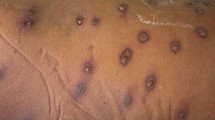Abstract
Wasp stings are not uncommon, particularly in the warmer climates, as people tend to spend longer times outside. A 49-year-old healthy gentleman had suffered multiple wasp stings all over his body. At the primary health centre, he was documented to have had flaccid quadriparesis with serum potassium of 2.3 mEq/L. At our institute, we diagnosed distal renal tubular acidosis. With history and investigations, we have excluded the major causes of distal renal tubular acidosis. We concluded that the wasp sting was responsible for distal renal tubular acidosis. The bradykinin contained in the wasp venom inhibits the basolateral 40-pS K + channel activity in the distal convoluted tubules and stimulates potassium excretion.
Similar content being viewed by others
Data Availability
Yes
Code Availability
Yes
References
D’Cruz S, Chauhan S, Singh R, Sachdev A, Lehl S. Wasp sting associated with type 1 renal tubular acidosis. Nephrol Dial Transplant. 2008;23(5):1754–5.
Agarwal V, D’Cruz S, Sachdev A, et al. Quadriparesis following a wasp sting. Ind J Med Sci. 2005;59:118–9.
Kurtzman NA. Disorders of distal acidification. Kidney Int. 1990;38(4):720–7.
Moreno M, Giralt E. Three valuable peptides from bee and wasp venoms for therapeutic and biotechnological use: melittin, apamin and mastoparan. Toxins (Basel). 2015;7(4):1126–50.
Zhang DD, Gao ZX, Vio CP, Xiao Y, Wu P, Zhang H, Guo XW, Meng XX, Gu L, Wang JL, Duan XP, Lin DH, Wang WH, Gu R. Bradykinin stimulates renal Na+ and K+ excretion by inhibiting the K+ channel (Kir41) in the distal convoluted tubule. Hypertension. 2018;72(2):361–9.
Author information
Authors and Affiliations
Contributions
Krishna Priya N, Navya T, Srilakshmi G: primary care takers of the patient. Ram R: faculty treated this patient and main author of the article. Siva Kumar V: one of the authors.
Corresponding author
Ethics declarations
Ethics Approval
Approved by institute ethics committee
Consent to Participate
Yes, obtained
Written Consent for Publication
Yes, obtained
Competing Interests
The authors declare no competing interests.
Additional information
Publisher's Note
Springer Nature remains neutral with regard to jurisdictional claims in published maps and institutional affiliations.
This article is part of the Topical Collection on Medicine.
Supplementary Information
Below is the link to the electronic supplementary material.
Rights and permissions
Springer Nature or its licensor (e.g. a society or other partner) holds exclusive rights to this article under a publishing agreement with the author(s) or other rightsholder(s); author self-archiving of the accepted manuscript version of this article is solely governed by the terms of such publishing agreement and applicable law.
About this article
Cite this article
N, K.P., T, N., G, S. et al. Renal Tubular Acidosis Following Wasp Sting: a Case Report. SN Compr. Clin. Med. 5, 77 (2023). https://doi.org/10.1007/s42399-023-01411-5
Accepted:
Published:
DOI: https://doi.org/10.1007/s42399-023-01411-5




